Hamas chief killed in attack on his residence in Tehran, IRGC says

Hamas chief Ismail Haniyeh and one of his bodyguards were killed after his residence was targeted in Tehran, Iran's Islamic Revolutionary Guard Corps (IRGC) confirmed in a statement.

Hamas chief Ismail Haniyeh and one of his bodyguards were killed after his residence was targeted in Tehran, Iran's Islamic Revolutionary Guard Corps (IRGC) confirmed in a statement.
A statement by the IRGC's Public Relations Department said the attack was carried out early Wednesday, adding that a probe is underway to find the cause of the incident.
The statement offered condolences to the people of Palestine, the Muslim world, and the Resistance Front's fighters over the Hamas leader's death.
A statement by Hamas says an "Israeli" raid killed the Palestinian group's leader Ismail Haniyeh in his residence in Tehran.
Mousa Abu Marzook, a member of Hamas political bureau, said the "cowardly" assassination of Ismail Haniyeh "won't go unanswered".
Earlier on Tuesday, Haniyeh had attended the inauguration of Iran's new president and met Iran's Supreme Leader.
The Palestinian leader was assassinated hours after praising Tehran's support for Hamas and Palestine during his meeting with Iran's President Masoud Pezeshkian.
Follows Iran International's Live Blog for the latest updates.

Masoud Pezeshkian is now officially Iran’s president. He was sworn in on Tuesday, having won the election after two rounds, both record-setters for low turnout (39.9% and 49.7% respectively).
In the second round, Pezeshkian’s campaign depicted his hardline rival as an existential threat to the livelihood of the nation. More people turned out for the run-off and Pezeshkian defeated the ultra-conservative Saeed Jalili. But he lost to those who boycotted the election. In the end, many more stayed at home than voted for the ‘reformist’ candidate.
So, the question is: how did Pezeshkian win despite failing to persuade the majority that he could deliver the reforms he promised? The answer, I argue in this piece, is the ethnic vote. (All data featured in this piece comes from official sources, and there are reasons to doubt their veracity. But that would be the subject for another article).
Ethnically, Iran is a highly diverse society. While the official language is Persian, millions of people have different mother tongues, such as Azari, Kurdish, Baluchi, and Arabic. These minorities often lack representation, particularly many Kurds and almost all Baluchis who are Sunnis, whereas most other groups, including the Arabic and Azeri speakers, are Shia.
Pezeshkian seems to come from a Azeri-speaking family, but he was born and raised among Kurds. Most minorities, ethnic and religious, picked him over Jalili, especially the Baluchis and the Kurds. But the focus here is on the Azari-speaking voters. (Note that most Turkish-speaking Iranians are Shia, which helps us single out the ethnic element.)
The figure below illustrates the role of the Azari speakers in Pezeshkian's victory. The horizontal axis represents the ratio of Azari speakers in each province. Azari belongs to the family of Turkic languages, which is also heavily influenced by Persian. Within Iran, people usually call it “Torki”, which means Turkish. The vertical axis represents the vote shares in the run-off, as a percentage of eligible voters in each province.
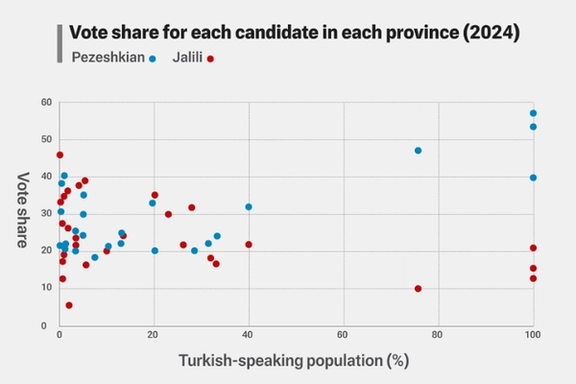
To better understand what seems to be a strong ethnic factor, we can consult the chart below, which shows the Azari or Turkish speaking population in each province.

Pezeshkian secured the highest share of vote in such provinces as East Azerbaijan, West Azerbaijan, Zanjan and Ardabil, where the majority are Azari (Turkish) speakers. In contrast, Jalili had an overall advantage in provinces with the lowest Azari-speaking populations. This does not mean that Jalili is popular among Persian-speaking Iranians. It seems to suggest that he did better than Pezeshkian in provinces with minimal ethnic minority presence.
The quantitative index of the Pearson Correlation Coefficient (PCC) is illuminating in this regard. The PCC index indicates the strength of the linear relationship and dependency between two variables. In the following diagram, each candidate’s vote share (in each province) is the dependent variable, and the relative size of the Turkish-speaking population (in that province) is the independent variable.
The correlation coefficient for Pezeshkian is 0.7 (70%), while for Jalili it is -0.47 ( -47). A positive value indicates that an increase in the independent variable leads to an increase in the dependent variable, whereas a negative value suggests that an increase in one variable results in a decrease in the other. The linear relationship for Pezeshkian's votes is strong and positive, suggesting that his share of vote (in most cases) rises as the Azari speaking population in a province increases. In contrast, the relationship for Jalili is weak and negative. (Same for Kurdish, Baloch, and Turkmen speakers).
One counterargument could be that the data should be interpreted differently: that the Persian-speaking population didn’t like Pezeshkian and voted for Jalili. But the low turnout in such provinces seem to refute this hypothesis. Moreover, in most of these provinces, Pezeshkian gained more in vote share as the turnout rose in the run-off.
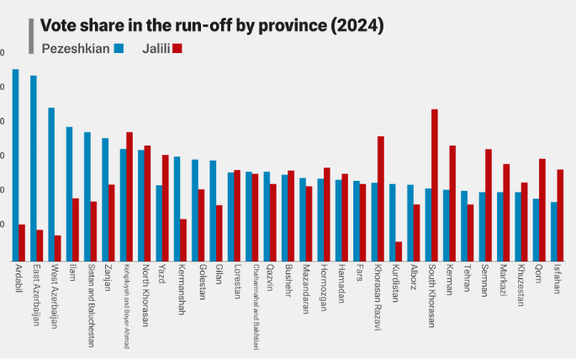
To underline the crucial role of the Azari (Turkish) speaking Iranians in the second round of the election, we can compare the results with that of the 2017 presidential election –where Hassan Rouhani tried to attract the ethnic vote.
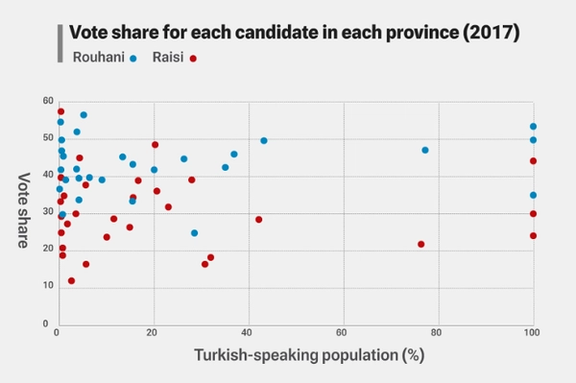
As seen above, Rouhani’s vote is more homogeneous across provinces, and the ‘Azari variable’ is less pronounced. Rouhani did receive more votes in provinces with majority Azari-speaking populations. But he also did so in the non-ethnic regions (except for Zanjan, where Raisi had more votes.)
The Pearson correlation coefficient for Rouhani is 5%, while for Raisi it is -10%. This indicates that the strength of the linear relationship between the two variables is much weaker. Azari speaking Iranians didn’t like Raisi, but their preference had much less impact on the final result that it did in 2024. It was insignificant statistically.
In the 2024 run-off, if we look at the Azari speaking provinces only, Pezeshkian got 2.8 million more votes than Jalili. That’s almost a million more than their vote difference in the first round. However, if we look at the six provinces where Persian is predominant, Jalili got about 830,000 more votes than Pezeshkian. In the first round, that number was about 275,000. In other words, the increase in the vote margin between Pezeshkian and Jalili in the second round is 3.7 times greater than the change observed in the six other provinces. Jalili’s advantage in Isfahan can be attributed to the low turnout (less than 50%). In Yazd, and Kerman, where official turnout in the run-off was above 50%, the changes may suggest a dramatic decline in the social standing of the reformists. In Khorasan Razavi, Jalili’s success may be due to local connections (he was born there). His lead (551,000 votes) is notably large and unexpected. In 2017, the picture was markedly different. Rouhani's advantage over Raisi in the six provinces mentioned above was 2.2 times greater than that of the four provinces with Azari speaking majorities.
Pezeshkian’s campaign may depict his presidency as a ‘reformist’ triumph. Previous ‘reform’ moments (1997, 2001, 2013, and 2017) were marked by national fervor and high turnout, neither of which transpired in 2024. Pezeshkian may name a few ‘reformists’ to his cabinet, and some may even call his administration a ‘reform government.’ The president himself acknowledges his indebtedness to Supreme Leader Ali Khamenei. However, the real story of Iran’s 2024 elections may very well be the ethnic vote.
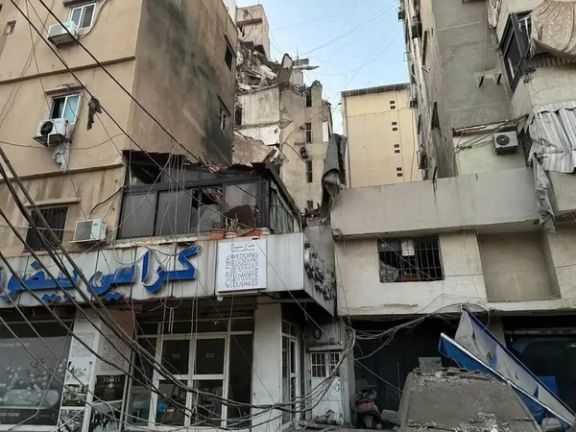
An Israeli airstrike targeted the suburbs of Beirut on Tuesday, killing a senior commander of Iran-backed Hezbollah, the Israeli military said, raising fears of the Israel-Hezbollah conflict escalating into a broader regional war.
The Israeli military carried out the airstrike in retaliation for a Saturday rocket attack on a soccer pitch in Golan Heights, which killed 12 minors. Israel and the US blamed Hezbollah for the attack, though the Shiite group denied responsibility.
The Tuesday airstrike killed Fuad Shukr, the "right-hand man" of Hezbollah Secretary-General Hassan Nasrallah who served as his adviser for planning and directing wartime operations, the Israel Defense Forces (IDF) said.
Three people have been killed and 74 others injured in the Israeli airstrike, Lebanon's Health Ministry announced. However, it did not identify the victims.
Al-Arabiya and Al-Hadath earlier confirmed that Fuad Shukr had been killed in the airstrike, and his body transferred to Beirut's Great Prophet Hospital.
"Fuad Shukr has directed Hezbollah's attacks on the State of Israel since October 8th, and he was the commander responsible for the murder of the 12 children in Majdal Shams in northern Israel on Saturday evening, as well as the killing of numerous Israelis and foreign nationals over the years," the IDF said in a statement.
"As the Head of Hezbollah's Strategic Unit, Fuad was responsible for the majority of Hezbollah's most advanced weaponry, including precise-guided missiles, cruise missiles, anti-ship missiles, long-range rockets, and UAVs. He was responsible for force build-up, planning, and execution of terror attacks against the State of Israel," the statement added.
The White House doubled down on its support for Israel in reaction to the strike that killed Shukr. “Our commitment to Israel’s security is ironclad and unwavering against all Iran-backed threats, including Lebanese Hezbollah,” National Security Council spokesperson Adrienne Watson said in a statement.
Vice-President Kamala Harris also said she “unequivocally” supports Israel’s right to defend itself "against the terrorist organization, which is exactly what Hezbollah is."
Iran's Foreign Ministry spokesman strongly condemned the Israeli airstrike, calling it a "clear violation of Lebanon's sovereignty and territorial integrity and a blatant violation of international rules and the UN Charter."
Iran's UN envoy in a letter to the Security Council said Israel's "cowardly" attack must be "unequivocally and immediately condemned by the Security Council."
"The Security Council must also take immediate action in response to this criminal act to ensure that such aggression, which threatens regional peace and security, is not repeated. Israel must be held accountable for these atrocities and cannot go unpunished," the letter said.
Iran’s newly elected president had earlier warned Israel of serious repercussions if it attacks Lebanon.
The hostilities between Israel and Hezbollah, largely triggered by the war in Gaza, are their worst since the 2006 conflict.
The clashes have largely been confined to the border area, with both sides previously expressing that they do not desire a broader conflict. However, the situation has raised concerns about the potential escalation towards war.
US attack on Iran-backed militants in Iraq
Shortly after the Israeli attack in Lebanon, the US military also carried out an airstrike targeting Tehran-backed combatants in Iraq who were allegedly attempting to launch one-way attack uncrewed aerial systems, Al-Arabiya reported, citing a US official.
“Based on recent attacks it was assessed that the UAS posed a threat to US and Coalition Forces,” the report said.
The US official did not provide further details, but Reuters cited Iraqi police and medical sources as saying that blasts inside a base used by Iran-backed Popular Mobilization Forces (PMF) militants south of Baghdad on Tuesday killed one member and wounded seven others.
The attack came a few days after a US military base in Syria's Conoco gas field was attacked for the second time in 24 hours with more than ten rockets fired from areas controlled by Iran-backed militants.
Over the past ten months, American bases in Iraq and Syria have been frequently attacked by Iran-backed militants, particularly the Islamic Resistance in Iraq, a coalition of Tehran's proxies which includes groups like Kataib Hezbollah, also a member of the Popular Mobilization Forces (PMF).
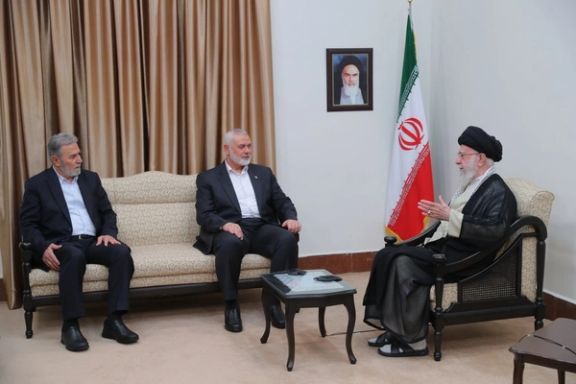
Supreme Leader Ali Khamenei and president-elect Masoud Pezeshkian held meetings with leaders of Iran-backed militant groups in Tehran including Hamas, Palestinian Islamic Jihad and the Houthis.
The meetings came before the swearing-in ceremony of Iranian president-elect Masoud Pezeshkian, highlighting Iran's ongoing support for the proxy militias.
During a separate meeting, Pezeshkian also expressed strong support for Hamas amid its war in Gaza, telling the group's political head Ismail Haniyeh, "We are certain that the resistance of the Palestinian people and fighters will lead to ultimate victory and the liberation of the land of Palestine."

Tehran has openly admitted to providing financial, logistical and training support to Hamas, praising the group's attacks on Israel on October 7 which killed 1,200 mostly civilians, while denying involvement in the specific operations. Hamas is now considered one of Iran's armed militant proxies in the region, alongside Lebanese Hezbollah.
In 2022, Haniyeh disclosed in an interview with Al Jazeera that his group had received $70 million in military aid from Iran. He noted, "We have rockets that are locally manufactured, but the long-range rockets came from abroad, from Iran, Syria, and others through Egypt."
The US State Department has previously estimated that Tehran's support for Palestinian terror groups, including Hamas, amounts to approximately $100 million annually.

Additionally, Pezeshkian met with Mohammed Abdul-Salam, the spokesman for Yemen's Houthi Ansarullah movement. He praised the group's recent actions against Israel and maritime navigation, remarking, "Your actions have clearly put pressure on the Zionist regime and its supporters." Pezeshkian also emphasized the necessity of collaboration among Islamic countries, stating, "We must work with Islamic countries to end the oppression of Muslims."
The Iran-backed Houthis have significantly disrupted the Red Sea, launching missile and drone attacks on commercial vessels. They claim to be acting in support of Palestinians, asserting that their targets are exclusively ships associated with Israel or its primary allies, the US and Britain. However, multiple ships without connections to Israel have targeted with dozens of non-Israeli hostages taken since November.
For several years, the clerical rulers in Iran have been the primary supporter of the Houthis, providing funding, arms, and training amid Yemen's civil war. This support has enabled the group to gain and maintain control over large parts of Yemen, despite facing a much stronger military coalition led by Saudi Arabia.

Naim Qassem, the Shia Lebanese cleric and deputy leader of Hezbollah, is also in Tehran to meet with Iranian officials and attend the oath-taking ceremony.
Since its establishment in 1979, the government in Iran has consistently positioned itself as a strong adversary of Israel and the United States. In the early 1980s, it founded the Lebanese Hezbollah as a proxy force to challenge Israel.
Currently on the brink of war with Israel, Hezbollah has been acting in allegiance with Hamas since October 8, sending 6,400 projectiles towards Israel's northern border in the worst tensions since 2006. Over 200,000 Israeli and Lebanese civilians have been displaced.
Over the past twenty years, Iran has expanded its influence by creating proxy groups in Iraq, Syria, Yemen, and the Palestinian territories. It also maintains networks in various other Middle Eastern, African, and Western nations.
Tehran provides Hezbollah, the largest and most powerful of its militias, with extensive financial aid estimated at hundreds of millions of dollars annually, in addition to advanced military equipment and training. Its missile arsenal is believed to be around 200,000. Hezbollah has been designated a terror group by countries including the US and UK.

Iran’s new president, Masoud Pezeshkian, was sworn in Tuesday, vowing to lift sanctions and engage in global dialogue, amid an audience of proxy militia leaders and a notable absence of high-ranking international officials.
The newly elected president was sworn in with the presence of the head of the judiciary and the Guardian Council, promising to uphold the constitution and faithfully execute his duties as the head of state.
It follows assumed office Sunday with Supreme Leader Ali Khamenei's approval.
In his speech, Pezeshkian attributed his election to the "wisdom of the leadership" and the "astute vote of the people," asserting that this election "has ushered in a new era of opportunity for both Iran and the world."
"We call upon Western nations to acknowledge the realities and foster relationships grounded in mutual respect and parity. We stand ready to manage tensions and engage in dialogue with those governments that have yet to recognize Iran's dignity and status.
"I affirm that the normalization of economic and trade relations with the global community is Iran's inalienable right, and I will tirelessly strive to lift these unjust sanctions," Pezeshkian said.
Vowing to stand strong on the world stage, which has seen Iran subject to sanctions for its nuclear program, human rights abuses and support of Russia's invasion of Ukraine, he said "the leadership will not succumb to pressure or excessive demands" while vowing to continue negotiations to lift the crippling sanctions.
"My administration will never yield to coercion, pressure, or double standards. The experience of over two decades of negotiations with Iran should have imparted to the negotiating governments that we have always upheld and will continue to uphold our commitments," he added.
In his opening remarks, Iranian Parliament Speaker Mohammad Bagher Ghalibaf said "the tragic death of late President Ebrahim Raisi and his companions presented a renewed test for the Islamic Republic of Iran in the eyes of global analysts", referring to the sudden death of Raisi who was killed in a freak helicopter crash.
He said through Khamenei, the event had become "a symbol of stability in Islamic Iran" as MPs chanted the slogan "Death to America" and "Death to Israel".
He stated, "The Parliament will utilize all available tools to support the government in the challenging path ahead."
Pezeshkian, consistent with his previous addresses, underscored the importance of adhering to the overarching policies championed by Khamenei.
The inauguration of new presidents in Iran involves a two-step process. Supreme Leader Ali Khamenei initially endorses the president-elect in an official ceremony known as Tanfiz. Subsequently, the newly endorsed president formally takes the oath of office before the parliament in the Tahlif ceremony.
Iran's Supreme Leader Ali Khamenei gave Pezeshkian the official presidential mandate on July 28 (Tanfiz) in a ceremony attended by multiple officials and dignitaries.
The president is allocated 15 days to submit his proposed cabinet ministers to the parliament for a vote of confidence, which is anticipated on September 5th.
Iran's state media reported that more than 80 foreign delegations from various countries and international organizations attended the swearing-in ceremony which Iranian officials said was a sign of the Islamic Republic's recognition on the global stage.
UAE Foreign Minister Abdullah bin Zayed, Tajikistan’s President Emomali Rahmon, Armenian Prime Minister Nikol Pashinyan, and Enrique Mora, the Chief of Staff to EU foreign policy chief Josep Borrell, were among the highest-ranking guests.
Other foreign guests represented neighboring countries and a few friendly governments in Africa and Latin America, and a low level delegation from Iran's ally and biggest oil consumer, China.
Before the ceremony on Tuesday, Pezeshkian met with leaders of Iran's regional proxies including Hamas leader Ismail Haniyeh and Mohammed Abdul-Salam, the spokesman for Yemen's Houthi Ansarullah movement, to express support for their actions against Israel.
On October 7, Gaza-based Hamas invaded Israel, killing 1,200 mostly civilians and taking over 250 more hostage. Since then, Iran's proxies have mobilized in support of the Palestinian group designated by countries including the UK.
Both Israeli and US targets in the region have come under fire from Iran's militias across the Middle East.
Since November, under the orders of Khamenei, the Iran-backed Houthis have significantly disrupted international commercial shipping in the Red Sea by attacking cargo ships and tankers in a bid to force Israel into a ceasefire amid the war in Gaza.
The United States and Britain have retaliated several times against Houthi military targets, yet have failed to deter the militia, which rules over more than half of Yemen.
The situation escalated this month when, for the first time, Israel's defense system failed to intercept a Houthi drone aimed at Tel Aviv. The drone struck an apartment building near the US Embassy branch office in Tel Aviv, resulting in the death of one person and injuring ten others.

Iran's Supreme Leader reaffirmed a steadfast commitment to strengthening ties with Yerevan during a meeting with Armenia's Prime Minister, emphasizing mutual benefits.
“We are deeply committed to enhancing our relations with Armenia, and the collaboration between our two nations, founded on mutual interests and independent of policies of others, will continue with unwavering strength,” Khamenei told Nikol Pashinyan on Tuesday.
Last week, Iran International reported that Tehran and Yerevan have signed an arms deal to supply Yerevan with military equipment and training valued at $500 million.
In a meeting preceding Iran's president-elect's swearing-in ceremony in parliament, Khamenei emphasized that the "security and prosperity of nations" are best ensured through self-reliance and fostering close cooperation with neighboring countries.
He stated that the "interference of distant powers" in the internal affairs of other nations "inevitably results in detrimental consequences for the interveners themselves."
After an apparent disappointment with its long-time ally, Russia, Armenia has been forging closer ties with the United States and France in recent months, including joint military drills with US forces in July.
According to a senior Middle Eastern military official, the reported Tehran-Yerevan agreement has been divided into several contracts and signed over the past few months. For security reasons, Iran International has withheld the official's identity.
Iran International has seen a list of military items Iran is purportedly set to supply Armenia, including drones such as the Shahed 136, Shahed 129, Shahed 197, and Mohajer, as well as air defense missile systems like the 3rd Khordad, Majid, 15th Khordad, and Arman.
The Iran-Armenia arms deal reportedly extends beyond providing suicide drones and air defense missiles. It encompasses intelligence cooperation, close military relations, training, and the establishment of bases on Armenian soil, the source disclosed to Iran International.
Following the report's publication, Armenia's Ministry of Foreign Affairs did not deny the deal in its official email response to Iran International. "Armenia is currently diversifying its security relations within the framework of international law. We don't have any further comment on this," stated a spokesperson for the Ministry of Foreign Affairs of the Republic of Armenia. Meanwhile, Iran's ambassador to Armenia, Mehdi Sobhani, denied the report.
Azerbaijan Republic is seeking a land corridor through Armenia to connect with the Azerbaijani enclave of Nakhichevan.
Khamenei says that Iran considers the Zangezur corridor “detrimental” to Armenia and “maintains a firm stance” on this issue.
"We are strongly committed to developing relations with Armenia, and cooperation between the two countries will continue robustly based on defined interests, without regard for the policies of others," Khamenei added during the meeting with Pashinyan.